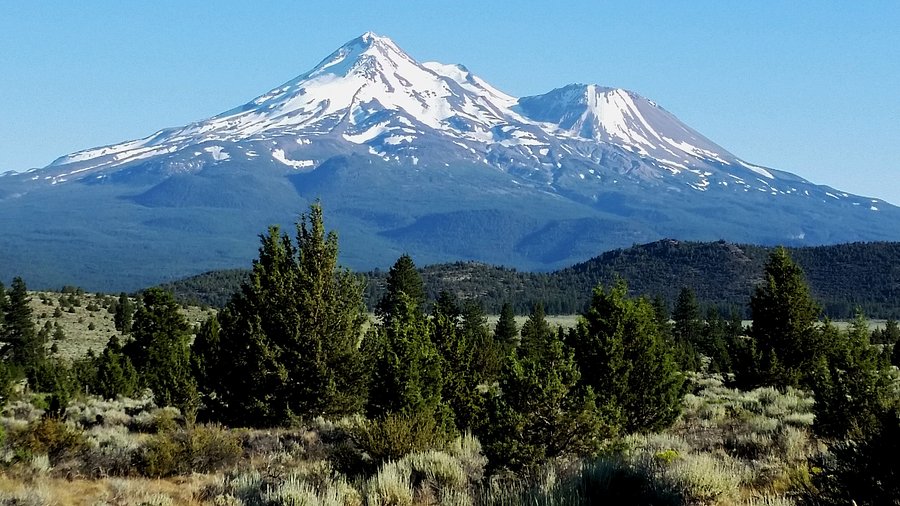Mt. Shasta stands at 14,179 feet, making it the second-tallest volcano in the United States. Along with winter activities like skiing, snowboarding, and tubing, mountaineering is a popular pursuit here.
Climbing Mt. Shasta is sustained effort that requires excellent physical conditioning, as well as the motivation and mental fortitude to tackle the significant challenge of ascending 7,000 vertical feet. While prior mountaineering experience is advised for some of the climbs, many routes to the summit are open to beginners.
Employing a guide is recommended to ensure mountaineers complete the climb safely. Among the available guides is Shasta Mountain Guides, which regularly leads mountaineers up a handful Mt. Shasta’s most popular routes.
Each of these routes boast unique characteristics and offer distinct challenges to mountaineers. To determine which route is best suited for you, let’s take a close look at some of the most popular.
Avalanche Gulch
Mountaineers typically attempt Mt. Shasta’s most popular route from April to June, when there’s plenty of snow. Climbing earlier or later in the season is possible, but conditions can vary and may be dangerous.
Typically a two- to four-day climb, Avalanche Gulch (also known as the John Muir Route) begins at 6,950 feet, at Bunny Flat trailhead. The route has different variations, but many mountaineers will ascend to Horse Camp, at about 7,900 feet, where there’s fresh water, a composting toilet, and good camping. Then, the established path proceeds to the Helen Lake moraine and upwards. Notable features include Misery Hill, a false summit that lives up to its name.
Reaching the summit itself is a challenge that requires equipment like crampons and a mountain axe, but there are ample rewards in the form of stunning views. Many people take at least one overnight to do the climb, but advanced mountaineers can tackle Avalanche Gulch in as little as a day.
Casaval Ridge
A moderately challenging route, Casaval Ridge does not require much in the way of technical skill. However, with the potential for long falls in precarious sections like the Catwalk, the route is not for beginners or the faint of heart.
The exposed sections, while dangerous, do allow for beautiful views, including in the form of breathtaking rock towers. Typically a two-day climb, Casaval Ridge is best attempted early in the season, when there’s significant snow. Mountaineers have the option to camp at a gulch at 9,800 feet or a flat bench at 10,300 feet, the latter of which often draws high winds.
Clear Creek
Mt. Shasta’s least difficult climb consists of a moderate hike along the first 75% of the route, followed by an easy climb to the summit. Climbers should be warned not to be careless, however—failing to pay attention can easily result in veering off-course into dangerous areas. In addition, gravel and other unsteady surfaces means it takes only one false step to lose your footing.
Climbers (especially beginners) should instead proceed slowly and take the time to admire views of Konwakiton Glacier, Wintun Glacier, Mud Creek Canyon, and Mt. Lassen in the distance. While fit climbers can complete this summer hike in as little as a day, camping and freshwater is available at 8,600 feet for those wanting to make a weekend out of it.
Hotlum Glacier
Ice climbers looking to enjoy some mid- or late-season climbing can end their search with Hotlum Glacier. Best accessed in July and August when the winter snowpack has melted away, Hotlum Glacier is a playground for the experienced mountaineer.
Ascending the lower portion of the glacier is relatively straightforward. With seasonal conditions altering the glacier dramatically, route-finding becomes more complex the higher one climbs, and even more so as mountaineers descend. Notable features on the climb down include the Hotlum Headwall, a treacherous 5.8 multi-pitch rock.
The Hotlum Glacier route typically takes two days to complete. Many alpinists who are successful here go on to bigger climbs like Denali and Mount Rainier.
Hotlum-Bolam Ridge
Don’t yet have the skills for Hotlum Glacier? Opt for Hotlum-Bolam Ridge instead, an intermediate-level route that provides a great introduction to glacier climbing.
Good bivouac sites can be found at a camp around 10,000 feet, and directly above is the climbing route. Because it is on the northeast side of the mountain, the Hotlum-Bolam route is best ascended in the summer, with conditions suitable even as late as September. New climbers may opt to ascend the ridge in three days, while those wanting more of a challenge can try for two.
West Face
Many skiers and snowboarders opt for the West Face because of its spectacular descent. With a fall line drop of close to 4,000 uninterrupted feet, it’s an experience mountaineers won’t soon forget.
As for the ascent, the West Face is similarly challenging to Avalanche Gulch. With fewer climbers, however, it feels far more remote.
The best time to complete the West Face is early in the season, and doing so typically takes two days. The route is home to some of the mountain’s most beautiful base camps—sitting at 9,200 feet, they’re the ideal place to prepare for a summit attempt.

